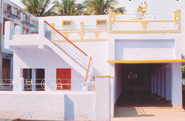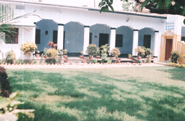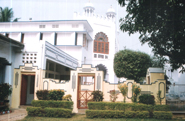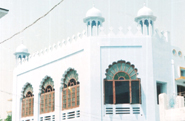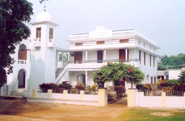Navigation
Khanquah Rahmani
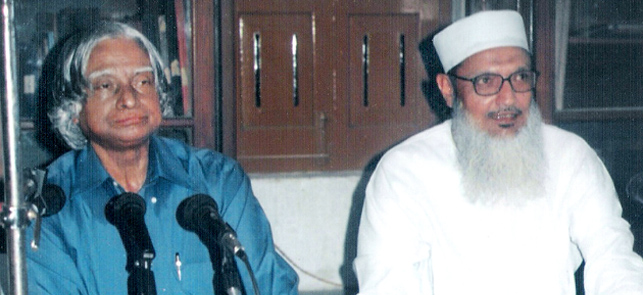
Introduction
Khanquah Rahmani was established in Munger in 1901 by the eminent scholar Hazrat Maulana Mohammad Ali Mungeri (r.A.), for the reformation of societies and purification of souls following the order of his Shaikh Hazrat Maulana Fazl-e-Rahman Ganj Muradabadi. Following his order, Maulana Mungeri left his birth place of Kanpur, U.P and migrated to Munger and established the Khanquah. Since its inception, by the mercy of Allah, the Khanquah has witnessed numerous transformed souls who have found peace and tranquility in the message of Islam. People come here to take a solemn pledge (bai’ah) to abandon sins, believe in the Islamic creed and follow Islam, by being kind and just to one-selves and to fellow human beings.
Hazrat Ameer-e-Shariat Maualana Minnatullah Rahmani Sahib engaged himself in the freedom struggle of India and was jailed twice by the British for these activities. He used the Khanquah very effectively to support the freedom struggle in addition to taking a pledge of reformation from the people, advising people to follow the straight path and working tirelessly to his last breath for the Ummah and the humanity at large.
Since the Independence, to guide the Government and all of its branches, Khanquah Rahmani has been used as a platform for protecting various rights and liberties as promised and guaranteed by the constitution; along with being the voice for social justice, education and public health.
Movement against Qadyanism and others
The institution has a history of successfully creating and managing reformation movements. Maulana Mungeri (r.A.) successfully defended the onslaught of the Qadyani movement, which at the turn of the century created a huge problem and caused severe confusions in the understanding of the Islamic belief system, for the Muslim communities in Bihar, Uttar Pradesh, Bengal and Orissa. To counter the technologically advanced propaganda of the Qadyanis, Maulana Mungeri (r.A.) established a printing press in 1922 to speed up the printing and distribution process of literature presenting the true image of Islam and answering the charges put forth by the Qadyanis.
Similarly Khanquah Rahmani was successful in spreading the correct understanding of Islam and mobilizing people against British Imperialists, Christians and Arya Samajhis, who sought to defame Islam and cause deliberate confusions in the Muslim’s minds.
Struggle for Independence
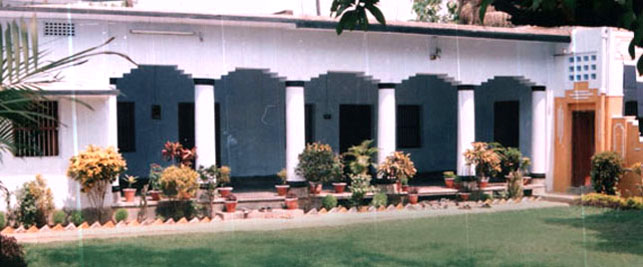
Playing a pioneering role in the freedom struggle of India, especially in the last 12 years of the freedom struggle, Khanquah Rahmani served as the center of information. This is the place where information for the freedom fighters and the general public addressing the revolution were printed and distributed throughout the state. The effectiveness of the services of the center prompted Gandhi Ji, Maulana Azad and Jawahar Lal Nehru to use the center for their stay and freedom work. Khanquah Rahmani was also visited and duly acknowledged by such personalities as Maulana Mohammad Ali Jauhar, Maulana Shaukat Ali, Dr. Rajendar Prasad, Khan Abdul Gaffar Khan Sahib “Frontier Gandhi” and later by Presidents, Prime Ministers and many others.
Establishment of All India Muslim Personal Law Board
All Indian Muslim Personal Law Board is a gift of this institution to the Muslims of India, and guidance to other minorities in India on how to protect their personal laws and their identities. This board was created to safeguard Islamic laws from any effort to make the personal laws uniform across the board; this was especially needed in the wake of the Adoption of Children Bill of 1972 that was tabled in the Parliament by the Union Minister Mr. H.R. Gokhle.
Hazrat Ameer-e-Shariat along with Hakeemul Islam Hazrat Maulana Qari Mohammad Taiyyab Sahib were able to unite all factions, parties and groups of Muslims and create one body to safeguard and further the cause of the Personal Law. The board was successful in the drafting and publication of Islamic personal laws; the courts of India are now required to use this document when judging Muslim civil cases. This has helped Muslims maintain their Islamic identity and character and follow the commands of Allah subhanahu wa ta’la. Additionally, since the initiation, this board has successfully protected the judiciary from their judicial overreach and the government from legislating against the Muslims and the minorities’ personal laws.
Resistance against Vasectomy & Tubal Ligation (“Nas-bandi”)
Hazrat Ameer-e-Shariat Maulana Minnatullah Rahmani Sahib used the Khanquah platform to create an all India wide and internationally acclaimed mass movement against the unrestrictive powers of the government; that were forcing the policy on men to undergo vasectomy and women to undergo tubal ligation thus preventing procreation. The government mandate put at stake the Islamic principles, moral principles and societal principles. After undergoing two years of struggle with the government and a mass movement behind it the movement obligated the government to abandon its policy and since then has prevented it from making such an umbrella policy pertaining to individual freedoms.
Resistance against Judicial overreaches – “The Uniform Civil Code”
The Adoption of Children Bill of 1972 by the Parliament stated that the adopted children will have no ties to their birth parents, but will have ties only to their adopted parents and these children will inherit from their adopted parents. Mr. H.R. Gokhle, the then Union Law Minister had termed this Bill as the first step towards Uniform Civil Code. This bill is in direct collision path with the Sharia and has impacts on Muslim marriages, inheritance, breast feeding and other rulings. The Government tried to subvert the Sharia Law by introducing this bill as a parallel legislation. This threat was fended off by establishment of the All India Muslim Personal Law Board and the movement it started.
The above case is the context in which the Shah Banu Case was considered a judicial overreach and activism. In one of the landmark cases against the Muslim Personal Law, the Supreme Court of India ruled that all people ought to be governed by a Uniform Civil Code. This ruling was feared that it will bring back the parallel legislation to undermine constitutional freedoms and guarantees promised to the minorities. The severity of the situation called for a movement to prevent the judiciary from their overreach and judicial activism into their interpretation of the law. Their interpretation tended to be against the minorities and to not safeguard individual and religious liberties as promised by the constitution. Hazrat Ameer-e-Shariat used Khanquah Rahmani to organize a movement to protect the rights of minorities and galvanized the opinion of the people in their own interest. This mass movement forced the government to reassess its position and then the Parliament of India brought in a new set of amendments clarifying and elaborating the rights and freedoms of minorities.
The movement to safeguard Islam
This movement is a continuous struggle against such Islamic forces that seek to mis-represent and or mis-interpret the Quran or the Sharia. The effort seeks to make Muslims and non-Muslims aware of the true understanding of the Sharia on any given mis-represented issue.
The movement against defamation of the Madaris
Pretending to counter the terrorism, the Government and the Home Department started equating Madaris and Mosques with places of terrorism. The Government created a high power sub-committee, a Group of Ministers (GOM) with the purpose to create new policies to fix lapses in the internal security. This committee presented its report which alleged that fundamentalism and terrorism is being taught at Madaris and that these places are used for trafficking.
The aftermath of 9/11, the rhetoric of the Government and the Media, the brewing tension and un-ease in the environment and the lack of voice of the Muslims prompted Hazrat Maulana Mohammad Wali Rahmani Sahib, now the patron of Khanquah Rahmani, to start a movement to preserve Islamic Identity (Tahreek-e-Tahaffuz-e-Shari’at). 54 conferences and public meetings were conducted to make people aware and to educate them on this danger. A national convention was held with complete support of all Muslim factions and political parties at Khanquah Rahmani. Mrs. Sonia Gandhi was due to attend this meeting as well, however she sent two of her dignitaries Mr. Arjun Singh and Mr. P. Shiv Shankar to attend the convention where both of them supported the demands of the Muslims. The movement was further strengthened when the President of India Dr. A.P.J. Abdul Kalam, during his visit to Khanquah Rahmani, publicly stated that “he has also studied at a Madrasah.” The meticulous planning and implementation of this movement and its massive support in the masses prevented the government from synonymizing madaris and mosques with terrorism, safeguarded every Muslim from being branded as a terrorist and no further action was taken on the report presented by the GOM.
Movement for Protection of Citizenship
The mid nineties saw an increased activity by the intelligence agencies and the government to secure the Bengal Border and deport Bangladeshis who have not returned back to their country. In this effort the government targeted eleven districts of Bihar and Bengal with a sizeable Muslim population. According to one report around 48,000 people were listed to be deported. Some of those people that received the notice by the Government to leave were themselves luminaries who had devoted their lives to the service of this land while others were immediate family members of these who were born here, lived here and held advanced bachelors’ and masters’ degrees. The illegal deportation of this magnitude would have left these people an alien and a refugee in a foreign land without any support and belonging and causing unspeakable emotional catastrophe on top of it.
A rigorous two year movement of education, clarification and court challenges were conducted culminating in a mass public rally at Araria district on 29 Nov, 1994, which was attended by more than 2.5 lakh people and several secular oriented Hindu leaders who denounce the government’s policies and called for cessation of the deportation policy in the name of Bangladeshis. Thankfully, the government understood the public’s outcry on this matter and terminated the process.
Reformation of Society (Islahe-Mu’ashra)
This is a program of the All India Muslim Personal Law Board to reform our societies and rid it of the evils that have seeped in. Hazrat Maulana Mohammad Wali Rahmani Sahib is the national convener of this program. The purpose of this program is to fight against evils such as dowry, declining moral character, intoxication, gambling, declining dignity of Muslim females, female infanticide etc. Every state in India has one or two committees that oversees the work of this program. Public awareness efforts are carried through conferences, seminars, information book-lets and one on one counseling sessions are in continuous progress.
